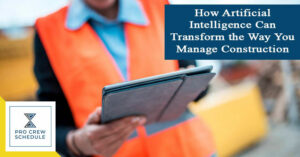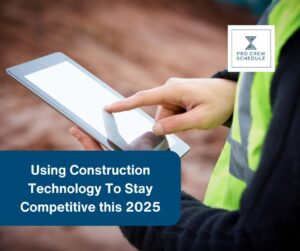In today’s modern world, construction technology has played an important role in improving the speed and safety of building projects while changing how general contractors and project managers handle construction. No doubt, construction is one of the most complex industries – it has to deal with many problems, such as the cost of projects, delays in building, and lack of workers. Artificial Intelligence, more commonly known as AI, has made our daily lives and day-to-day operations much easier. For example, many industries use it to its fullest potential, helping businesses grow by leaps and bounds.
However, many in the construction industry still need to learn to avoid traditional, tried-and-tested construction management methods. As a result, the construction industry still needs to catch up with digitization, especially with the significant technological developments over the past free years.
So, the big question is, what is AI, and how can it change how you manage your construction project? In this article, let us look at the different types of AI and how you can integrate them into your daily operations.
What is Artificial Intelligence (AI) in Construction?
Artificial Intelligence (AI) is defined by Encyclopedia Britannica as a broad term for a machine acting like a person in ways like solving problems, recognizing patterns, and learning (Artificial intelligence | Definition, Examples, Types, Applications, Companies, & Facts | Britannica). It involves machine learning, which utilizes statistical methods to let computers learn from data. There are many ways that machine learning and AI could be used in construction. In the industry, requests for information, open issues, and change orders are all common. AI can tell a project manager the most important things they need to pay attention to, depending on its capabilities and how it is programmed. The construction industry has much room for improvement and productivity if Artificial Intelligence and digital technologies are utilized properly.
Understanding The Critical Role of AI in Smart Construction
In the construction industry, Artificial Intelligence is going through a digital transformation. Focusing on technologies like Artificial Intelligence, Machine Learning, or construction process improvement software from the preconstruction phase until the project handover is taking the construction industry to new heights. Utilizing these technologies can make a big difference in the construction industry by helping tasks get done faster and cheaper.
The construction industry is well-known for being one of the least digitalized and slowest to adopt new technology. It is held back by people who prefer the old, manual ways of managing construction, such as monitoring progress and inventory through the traditional pen-and-paper or complicated spreadsheets. This causes project delays, wastes money, and hurts productivity, health, and safety.
This technology change is likely good for everyone involved in the project, such as contractors, owners, and service providers. This makes it even more important for the construction industry to adapt to the digitization of processes. You can easily deal with current problems and avoid making the same mistakes in the past.
Different Types of Artificial Intelligences
If you have been in the industry for a long time or are a newbie in construction, then it is critical to know how AI is used. AI will hugely change the construction industry and can streamline and optimize operations to consistently deliver high-quality projects on schedule and within budget. In this section, let us look at the different types of AIs.
Virtual Reality
Virtual Reality (VR) is one of the construction technologies commonly used. Builders can give clients a virtual tour of the project to have a clear picture of its outcome. This can also help the designers and engineers evaluate the building and make any changes needed to meet the client’s needs. It will help make the customer experience and satisfaction better as a whole.
3D Printing
3D printing can let you build structures more accurately in less time and with less waste and less money spent on labor. You have a scale model of your project. You can review and evaluate your design to determine if it is feasible or if you need to make a few changes here and there. AI and 3D printing have a lot of potential for the construction industry.
Building Information Modeling (BIM)
Building information modeling (BIM) uses 3D models to give architects, engineers, and builders the information they need to plan, design, build, and manage buildings and infrastructure. The different models in each subcategory must not clash with each other. For example, your electrical system should be separate from your fire protection system. In AI, machine learning is used to find and fix these conflicts.
Big Data Analysis
At a time when huge amounts of data are being created every day, AI systems have access to an infinite amount of data from which they can learn and get better every day. Construction is made up of a million moving parts – and with this comes a huge amount of data that need to be processed and interpreted daily. Data from mobile phone photos, drone videos, security sensors, and building information modeling can be analyzed by AI to give you valuable insights into how your project is progressing.
Construction Software
Even when they have the best teams or an integrated and personalized approach, most construction projects are still at risk of delays and cost overruns. AI technologies, such as artificial neural networks, can predict cost overruns based on project size, the type of contract, and the skill level of the project manager. Construction scheduling software can create realistic schedules for future projects and avoid construction delays. AI can also help managers keep track of all the different things going on at construction sites and predict how the prices of building materials will change.
Integrating Artificial Intelligence into Your Daily Construction Operations
AI technologies can change how construction projects are handled and managed – and in a good way. Since the change in technology in engineering and construction is just starting, companies that upgrade their technology will do well. However, you need to find the right technology or software for your organization so that you can use it to its full potential.
With statistical machine learning techniques in construction, it is much easier, and it takes less time to look at data about changed orders, requests for information, etc. This will help the project leaders know what must be done immediately.
Prevent Cost and Budget Overruns
Construction projects almost always go over budget, and the bigger the project – the bigger the cost overruns are likely to be. Using AI and Big Data analytics together, you can make reports for past projects, figure out where they went over budget, and make better budget predictions for future ones. Similarly, you can utilize construction inventory software to manage your stock levels better, streamline your supply chain and avoid costly delays. For example, you can use AI to determine when you need a specific resource, the best time to order, and the rate at which it will be used.
Increasing Job Safety
AI can not only get information from the sensors in your equipment, but it can also manage how people and things move around the site. This cuts down on accidents by ensuring that broken equipment is found before it breaks, that equipment like cranes doesn’t block access to important areas, and more. The AI I can be connected to security cameras to watch for unsafe actions or events. Facial recognition technology can warn workers who might be in danger.
Design and Build Better Buildings
More and more design firms are adding AIs to their design processes to show 3D walkthroughs of their projects and predict problems faster than ever. These models can be updated automatically as each team changes the building’s wiring, plumbing, or structure. Predictive analytics can be run on the data to help key features fit together smoothly.
Streamlined and Optimized Project Planning
AI can help design better buildings and keep costs from going over budget. It can also help with other parts of project planning, like scheduling and finding materials, and train better managers by looking at data from the past. It can also help with time management in construction by helping you predict how the weather and other potential roadblocks early on in the project. The algorithms in this process learn from their mistakes to make better future decisions, and they do this at speeds that a computer can only do.
Off-Site Construction
Construction companies are relying more and more on off-site factories. In these factories, autonomous robots assemble parts of a building, which human workers assemble on-site. Structures like walls can be built in an assembly line by self-driving machines that are more efficient than humans. When the building is assembled, humans can finish the details like plumbing, HVAC, and electrical systems. These can further streamline the process, reducing downtime when manufacturing these items on-site with your crew.
Risk Mitigation
Every construction project has some risks, like quality, safety, time, or cost risks. As more subcontractors work on different trades simultaneously on job sites, the risk increases with the size of the project. Today, general contractors use AI and machine learning to track and prioritize risk on the job site so that the project team can focus their limited time and resources on the biggest risk factors. You can use construction time tracking software to evaluate possible risks and check if your team is progressing according to plan or if you need assistance to finish the job on schedule.







